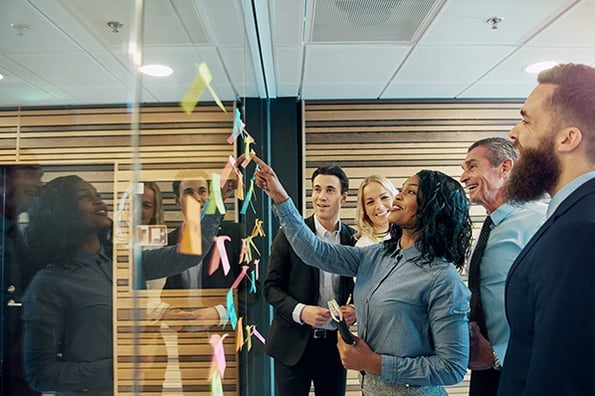You have a tenure problem.

Per Business Insider, out of the top 10 largest tech companies, only Facebook breaks the two-year mark (2.02) in average tenure. Uber falls at 1.23, Snap at 1.62, and Airbnb at 1.64.
I wonder how long the average onboarding period is per company? Or how long it takes to fill those roles after they leave? The more you look into it, the more you realize the amount of employee ROI companies are losing from employees frequently moving is exorbitant.
There’s certainly many reasons for the decline in tenure, with people who are far more intelligent than I am who could better explain them. However, from my perspective, there’s one area that seems to be ripe for disruption:
Structured vertical roles lead by traditional managers focused on rigid annual goals.
One potential solution that’s being more widely discussed? Mission-critical roles (or teams).
With the help of a solid organizational infrastructure enabled by AI, companies will soon realize the benefits of organizing and deploying flexible mission-critical teams on a project basis.
So what is a Mission Critical Role? Put simply, it’s a role that’s critical to the mission. However, similar to AI, the definitions, applications, and understanding will all change based on the specific environment. The way I see it, I like to use the analogy of the Army vs. Special Forces.
The Army is a massive organization where roles are very specific and siloed. While it’s clunky and moves relatively slow, it’s power is massive. Its ability to pivot quickly is hindered, but in all-out war, it would be a tough foe to contend with.
Special Forces units are small, usually composing teams of twelve. They are incredibly versatile and highly trained, with each member being able to take on multiple different roles. If someone is lost, the unit’s ability to fill that role quickly is a huge key to their success.
Now let me ask you a question. If you had a project that required very specific expertise, a tactical strategy that didn’t allow for much error, and needed to be completed as quickly as possible, who would you choose?
I’m guessing most people would choose the Special Forces Unit.
Frankly, the way young companies organize has changed. All out war on a massive scale is slowly becoming a thing of the past -- unless you’re one of the largest tech companies: Google, Apple, and Facebook. However, even these giants are taking the charge on more pliable, mission-critical teams.
Huge conglomerates are realizing that their ability to defend against these smaller, better-trained units with incredibly specific missions are slowly chipping away at them due to their broad strategies and slower movement.
Now let’s get back to the problem of tenure. Ask yourself a simple question, or better yet, survey your employees on how they would rank the impact of more cognitive and diverse work opportunities. Ask them about how it would impact tenure, overall satisfaction, devotion to the company mission and strategy, etc.
I’m going to take a guess and say that most of the feedback centered around the fact that more cognitive, diverse work opportunities would have a positive impact on your employees.
So that’s great, you’re thinking. I can hear you saying it now : What? Do you just expect me to go change up my whole organizational infrastructure?
Not quite. This is post is aimed at preparing you for the future. As of now, changing the entire organization over to mission-critical teams that bounce around from project to project is unrealistic for the vast majority of companies.
Preparing for Disruption
In the article, The Firm of the Future, written by three Partners at Bain and Co, they discuss Mission Critical Roles along with the concept of ‘Engine1, Engine2’. They primarily define Engine1 as your core business that drives most of your revenue creation (80% +). They then define Engine2 as ‘tomorrow’s business’. I like to refer to it as your moonshot program, where you’re poking and prodding the future to see what opportunities you could jump on.
By having Mission Critical Teams lead the bulwark of your Engine2 operations, you’re priming yourself for more disruptive innovation and you’re also future-proofing your growth. However, one thing I’d like to suggest is having your Engine2 operations focus on two things : future growth channels/products/services, and also looking internally (at Engine1) in regards to how they can vastly improve operations and productivity.
By having a bi-directional strategy built into your Engine2, which is funded by Engine1, you can drive opportunities to make your larger Engine1 move quicker while developing your business for tomorrow in Engine2.
What will Mission Critical Teams look like?
Like I mentioned above, most people will have different ideas as to what this will look like in practice. I personally think these attributes will play a large part in defining these roles and teams in the future:
- Speed : the ability to quickly research, gather and structure data, develop processes and models, and create feedback loops that allow for agile iteration
- Allocation & Accessibility: provisioning these teams universal access to data and resources that they can quickly tap into
- Autonomy : allow for self-management and their ability to choose one of their own to take point depending on the specific project
- Emotional Intelligence : the people who fill these roles need to be the most adaptable people in the organization, who can learn fast and utilize their foundational skills to effectively deal with any mission or project
- Simplicity : these teams will be built on the idea that there is no toleration for over-complexity. Simplification at all levels of the organization will drive this team’s ability to perform and allow them to easily work in any part of the ecosystem
- Precision & Imagination : just like the brain, these teams will need to employ left and right thinkers who are effective in communicating with each other
Considering all of the points above, there’s one more over-arching thing that will be key to success — Artificial Intelligence.
These teams will utilize AI and machine learning extensively in their day-to-day operations and have the ability to move at breakneck speeds.
Some ideas on how AI will enable them:
- Identifying both opportunities and organizational vulnerabilities in massive data sets
- Allocation of information and resources that allow for hyper-targeted R&D
- Predictive modeling around development of new products and services
- Rapid deployment and faster iterations at every stage of the project cycle
How will this impact business?
Three primary things:
- The development of future opportunities & growth channels
- Increase in employee tenure
- Refined organizational strategy and higher overall productivity
The way I see it, the amount of return companies are losing due to the existing structure is exorbitant. If the average tenure for the top 10 largest tech companies is less than 2 years, with a three-five month onboarding until the employee is in peak productivity, that equates to around 14–18 months of peak productivity.
Now considering the cost of filling that role in the first place, the cost of finding a replacement who needs to go through a new onboarding program, you begin to see that this approach is ripe for disruption. Exploring the deployment of mission-critical roles in your Engine2 operations is a great way to not only test this out but iterate on how it could work for your entire organization.
Interested in how to approach other emerging technologies? Check out our guide - A Practical Approach to Emerging Tech for SMBs.



![Real or AI-Generated? You Guess [Quiz]](https://www.hubspot.com/hubfs/real%20or%20ai.png)

![AI Predictions that Could Impact Marketers in 2025 [Trending Data & Expert Insights]](https://www.hubspot.com/hubfs/AI%20predictions.png)




